Managing Employment Relation
VerifiedAdded on 2022/12/28
|11
|2430
|1
AI Summary
The employment relationship is the management of communication and relations between employer and employee, organisations and state and the trade union. This essay will compare and contrast the employment relations of Australia and China to understand where these countries stand in their industrial relation policies.
Contribute Materials
Your contribution can guide someone’s learning journey. Share your
documents today.
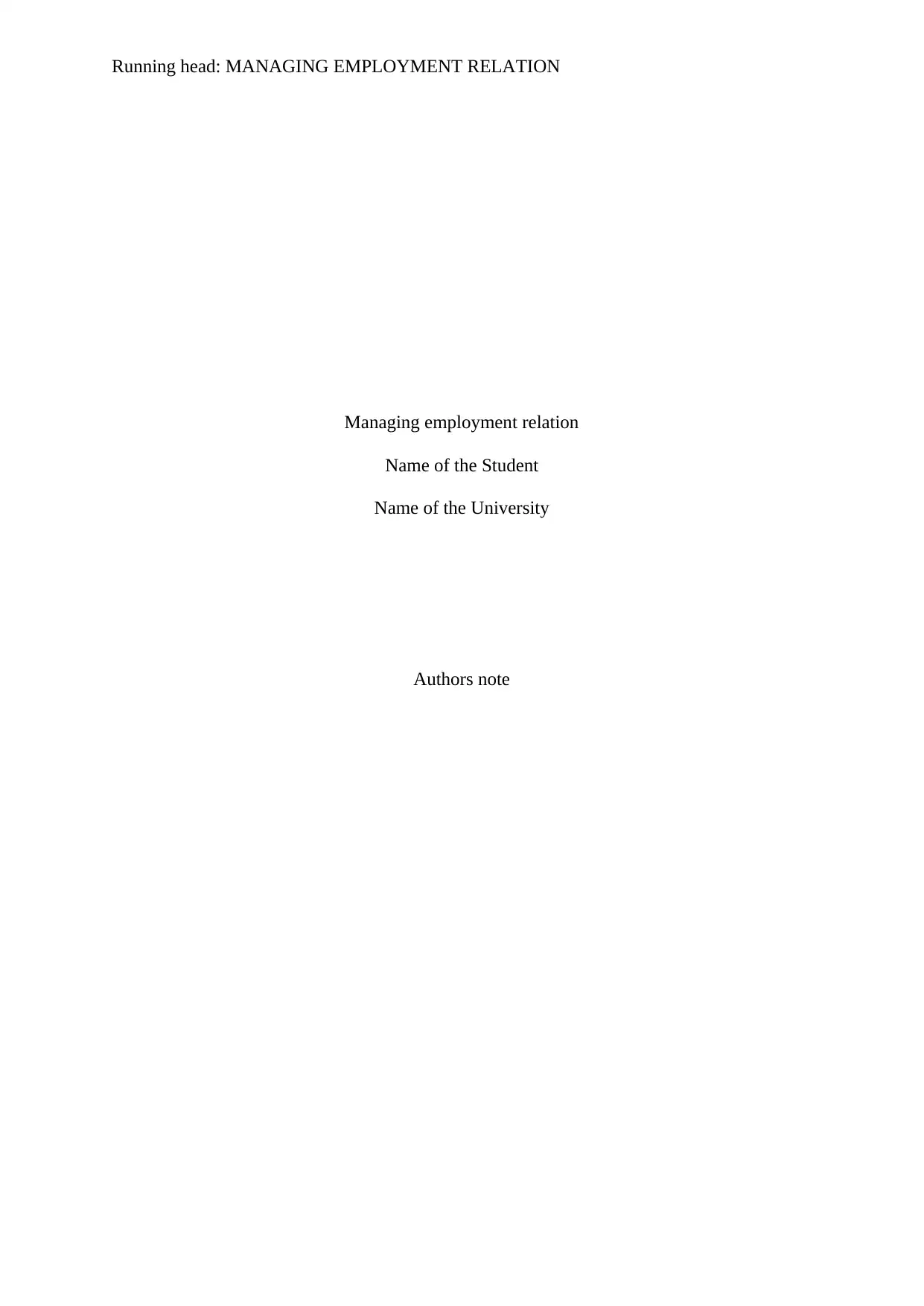
Running head: MANAGING EMPLOYMENT RELATION
Managing employment relation
Name of the Student
Name of the University
Authors note
Managing employment relation
Name of the Student
Name of the University
Authors note
Secure Best Marks with AI Grader
Need help grading? Try our AI Grader for instant feedback on your assignments.
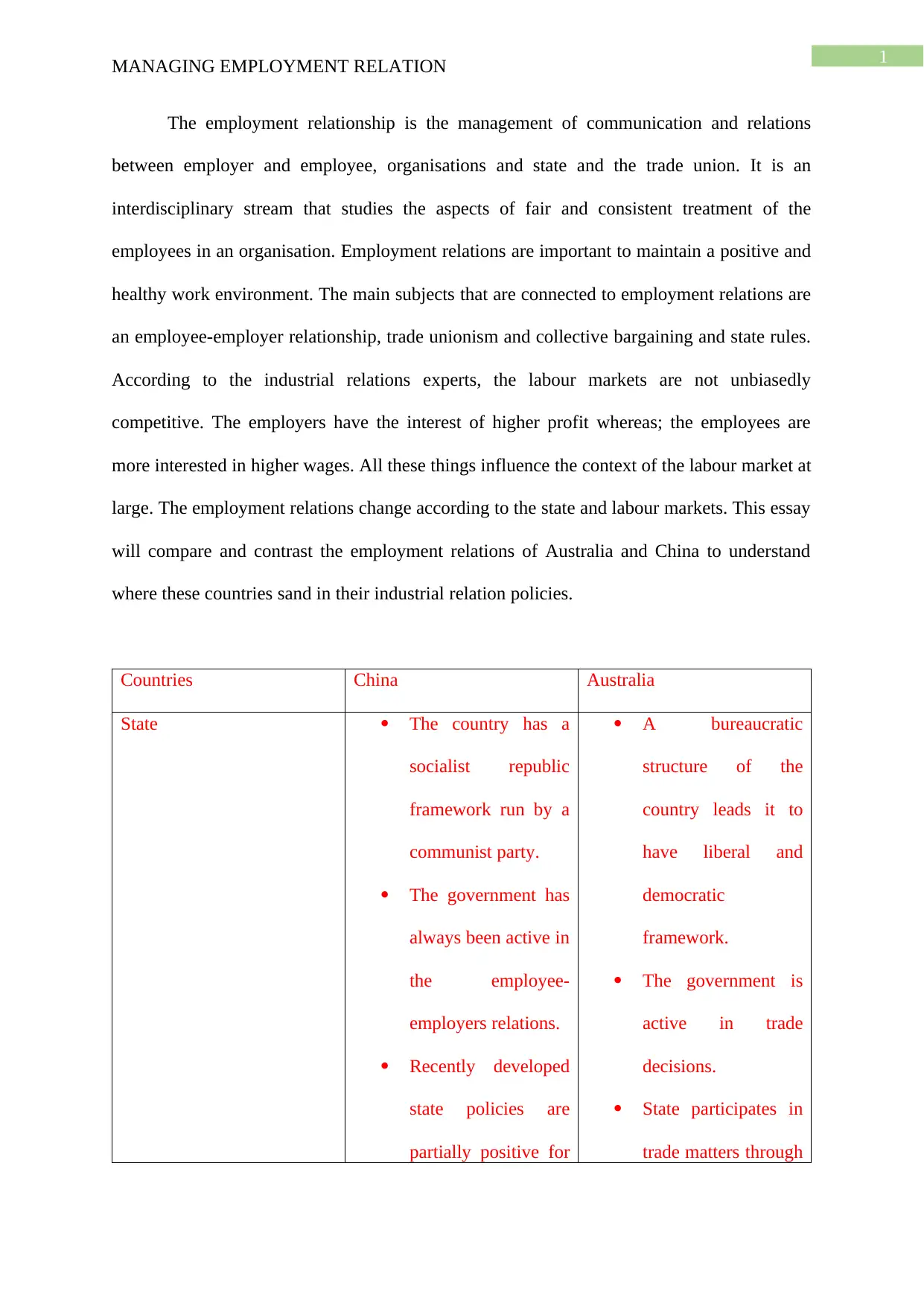
1
MANAGING EMPLOYMENT RELATION
The employment relationship is the management of communication and relations
between employer and employee, organisations and state and the trade union. It is an
interdisciplinary stream that studies the aspects of fair and consistent treatment of the
employees in an organisation. Employment relations are important to maintain a positive and
healthy work environment. The main subjects that are connected to employment relations are
an employee-employer relationship, trade unionism and collective bargaining and state rules.
According to the industrial relations experts, the labour markets are not unbiasedly
competitive. The employers have the interest of higher profit whereas; the employees are
more interested in higher wages. All these things influence the context of the labour market at
large. The employment relations change according to the state and labour markets. This essay
will compare and contrast the employment relations of Australia and China to understand
where these countries sand in their industrial relation policies.
Countries China Australia
State The country has a
socialist republic
framework run by a
communist party.
The government has
always been active in
the employee-
employers relations.
Recently developed
state policies are
partially positive for
A bureaucratic
structure of the
country leads it to
have liberal and
democratic
framework.
The government is
active in trade
decisions.
State participates in
trade matters through
MANAGING EMPLOYMENT RELATION
The employment relationship is the management of communication and relations
between employer and employee, organisations and state and the trade union. It is an
interdisciplinary stream that studies the aspects of fair and consistent treatment of the
employees in an organisation. Employment relations are important to maintain a positive and
healthy work environment. The main subjects that are connected to employment relations are
an employee-employer relationship, trade unionism and collective bargaining and state rules.
According to the industrial relations experts, the labour markets are not unbiasedly
competitive. The employers have the interest of higher profit whereas; the employees are
more interested in higher wages. All these things influence the context of the labour market at
large. The employment relations change according to the state and labour markets. This essay
will compare and contrast the employment relations of Australia and China to understand
where these countries sand in their industrial relation policies.
Countries China Australia
State The country has a
socialist republic
framework run by a
communist party.
The government has
always been active in
the employee-
employers relations.
Recently developed
state policies are
partially positive for
A bureaucratic
structure of the
country leads it to
have liberal and
democratic
framework.
The government is
active in trade
decisions.
State participates in
trade matters through
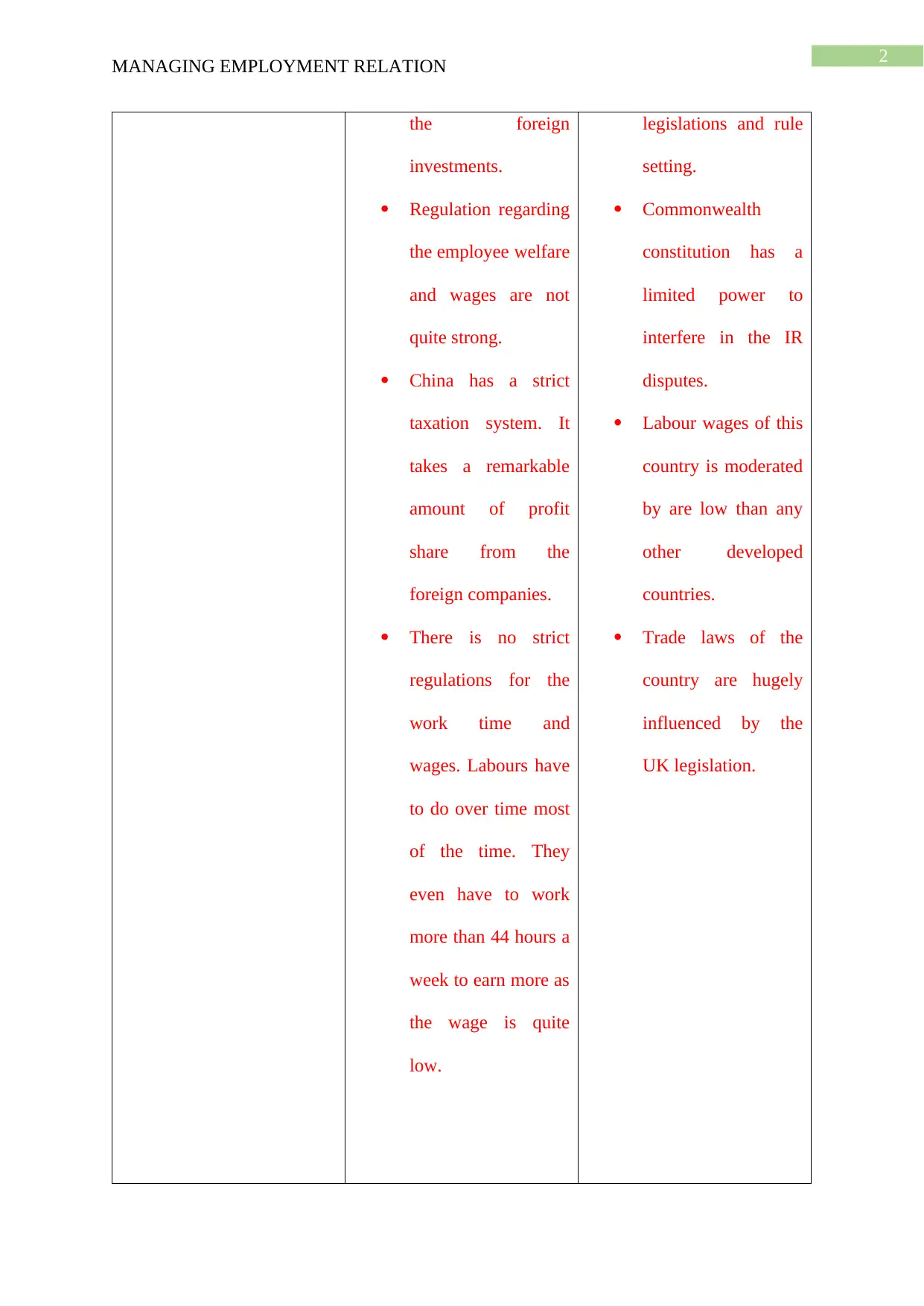
2
MANAGING EMPLOYMENT RELATION
the foreign
investments.
Regulation regarding
the employee welfare
and wages are not
quite strong.
China has a strict
taxation system. It
takes a remarkable
amount of profit
share from the
foreign companies.
There is no strict
regulations for the
work time and
wages. Labours have
to do over time most
of the time. They
even have to work
more than 44 hours a
week to earn more as
the wage is quite
low.
legislations and rule
setting.
Commonwealth
constitution has a
limited power to
interfere in the IR
disputes.
Labour wages of this
country is moderated
by are low than any
other developed
countries.
Trade laws of the
country are hugely
influenced by the
UK legislation.
MANAGING EMPLOYMENT RELATION
the foreign
investments.
Regulation regarding
the employee welfare
and wages are not
quite strong.
China has a strict
taxation system. It
takes a remarkable
amount of profit
share from the
foreign companies.
There is no strict
regulations for the
work time and
wages. Labours have
to do over time most
of the time. They
even have to work
more than 44 hours a
week to earn more as
the wage is quite
low.
legislations and rule
setting.
Commonwealth
constitution has a
limited power to
interfere in the IR
disputes.
Labour wages of this
country is moderated
by are low than any
other developed
countries.
Trade laws of the
country are hugely
influenced by the
UK legislation.
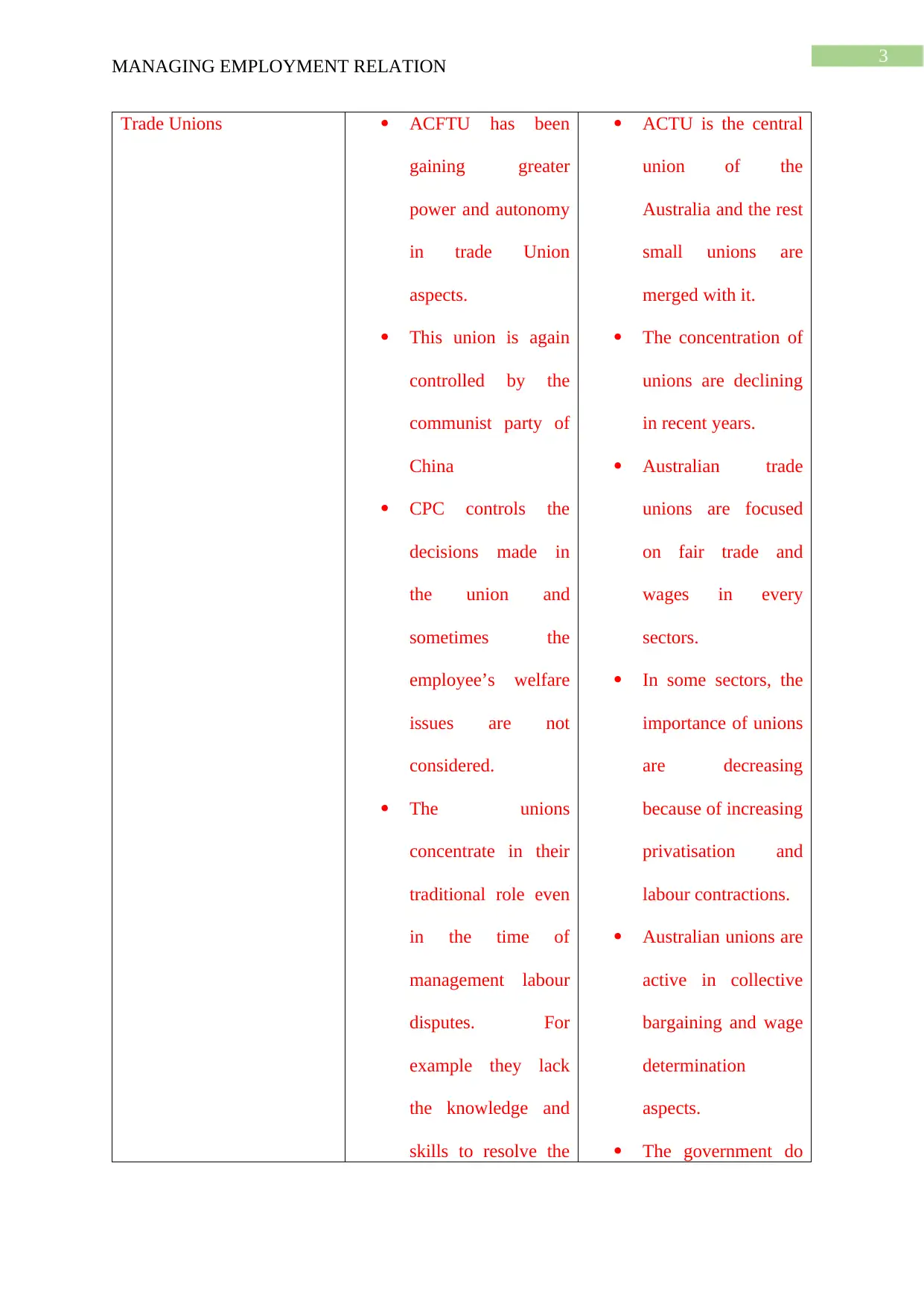
3
MANAGING EMPLOYMENT RELATION
Trade Unions ACFTU has been
gaining greater
power and autonomy
in trade Union
aspects.
This union is again
controlled by the
communist party of
China
CPC controls the
decisions made in
the union and
sometimes the
employee’s welfare
issues are not
considered.
The unions
concentrate in their
traditional role even
in the time of
management labour
disputes. For
example they lack
the knowledge and
skills to resolve the
ACTU is the central
union of the
Australia and the rest
small unions are
merged with it.
The concentration of
unions are declining
in recent years.
Australian trade
unions are focused
on fair trade and
wages in every
sectors.
In some sectors, the
importance of unions
are decreasing
because of increasing
privatisation and
labour contractions.
Australian unions are
active in collective
bargaining and wage
determination
aspects.
The government do
MANAGING EMPLOYMENT RELATION
Trade Unions ACFTU has been
gaining greater
power and autonomy
in trade Union
aspects.
This union is again
controlled by the
communist party of
China
CPC controls the
decisions made in
the union and
sometimes the
employee’s welfare
issues are not
considered.
The unions
concentrate in their
traditional role even
in the time of
management labour
disputes. For
example they lack
the knowledge and
skills to resolve the
ACTU is the central
union of the
Australia and the rest
small unions are
merged with it.
The concentration of
unions are declining
in recent years.
Australian trade
unions are focused
on fair trade and
wages in every
sectors.
In some sectors, the
importance of unions
are decreasing
because of increasing
privatisation and
labour contractions.
Australian unions are
active in collective
bargaining and wage
determination
aspects.
The government do
Secure Best Marks with AI Grader
Need help grading? Try our AI Grader for instant feedback on your assignments.
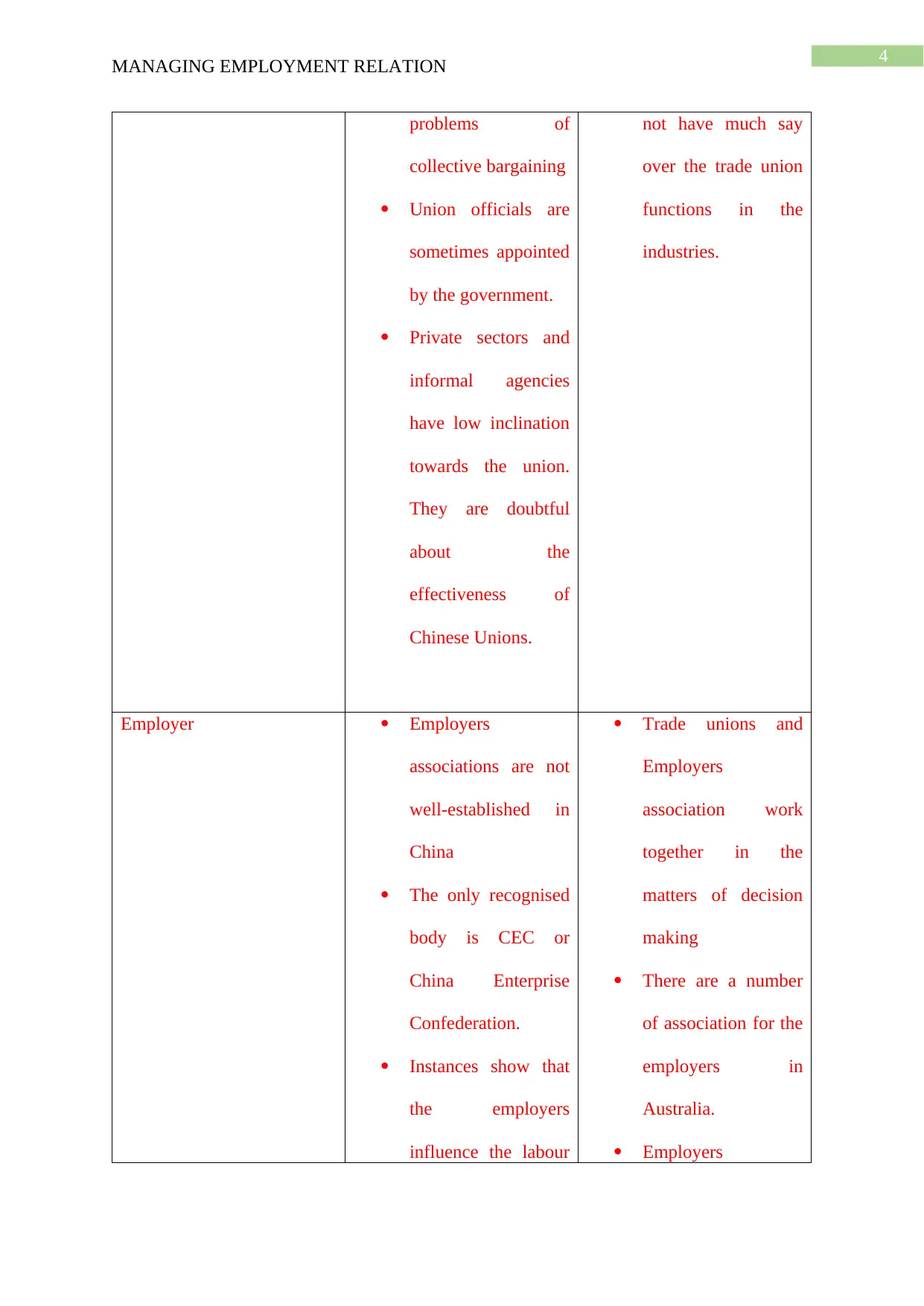
4
MANAGING EMPLOYMENT RELATION
problems of
collective bargaining
Union officials are
sometimes appointed
by the government.
Private sectors and
informal agencies
have low inclination
towards the union.
They are doubtful
about the
effectiveness of
Chinese Unions.
not have much say
over the trade union
functions in the
industries.
Employer Employers
associations are not
well-established in
China
The only recognised
body is CEC or
China Enterprise
Confederation.
Instances show that
the employers
influence the labour
Trade unions and
Employers
association work
together in the
matters of decision
making
There are a number
of association for the
employers in
Australia.
Employers
MANAGING EMPLOYMENT RELATION
problems of
collective bargaining
Union officials are
sometimes appointed
by the government.
Private sectors and
informal agencies
have low inclination
towards the union.
They are doubtful
about the
effectiveness of
Chinese Unions.
not have much say
over the trade union
functions in the
industries.
Employer Employers
associations are not
well-established in
China
The only recognised
body is CEC or
China Enterprise
Confederation.
Instances show that
the employers
influence the labour
Trade unions and
Employers
association work
together in the
matters of decision
making
There are a number
of association for the
employers in
Australia.
Employers
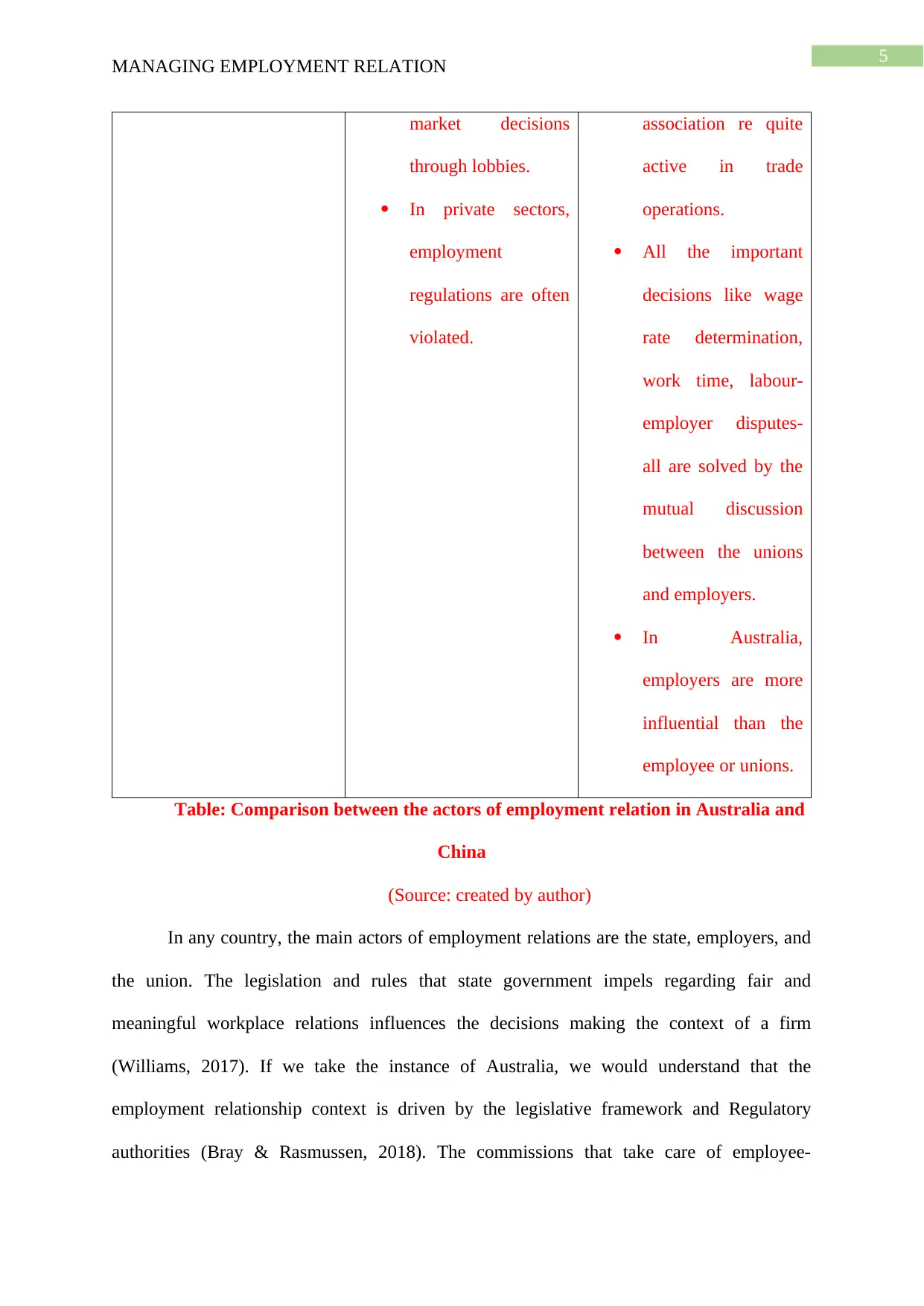
5
MANAGING EMPLOYMENT RELATION
market decisions
through lobbies.
In private sectors,
employment
regulations are often
violated.
association re quite
active in trade
operations.
All the important
decisions like wage
rate determination,
work time, labour-
employer disputes-
all are solved by the
mutual discussion
between the unions
and employers.
In Australia,
employers are more
influential than the
employee or unions.
Table: Comparison between the actors of employment relation in Australia and
China
(Source: created by author)
In any country, the main actors of employment relations are the state, employers, and
the union. The legislation and rules that state government impels regarding fair and
meaningful workplace relations influences the decisions making the context of a firm
(Williams, 2017). If we take the instance of Australia, we would understand that the
employment relationship context is driven by the legislative framework and Regulatory
authorities (Bray & Rasmussen, 2018). The commissions that take care of employee-
MANAGING EMPLOYMENT RELATION
market decisions
through lobbies.
In private sectors,
employment
regulations are often
violated.
association re quite
active in trade
operations.
All the important
decisions like wage
rate determination,
work time, labour-
employer disputes-
all are solved by the
mutual discussion
between the unions
and employers.
In Australia,
employers are more
influential than the
employee or unions.
Table: Comparison between the actors of employment relation in Australia and
China
(Source: created by author)
In any country, the main actors of employment relations are the state, employers, and
the union. The legislation and rules that state government impels regarding fair and
meaningful workplace relations influences the decisions making the context of a firm
(Williams, 2017). If we take the instance of Australia, we would understand that the
employment relationship context is driven by the legislative framework and Regulatory
authorities (Bray & Rasmussen, 2018). The commissions that take care of employee-
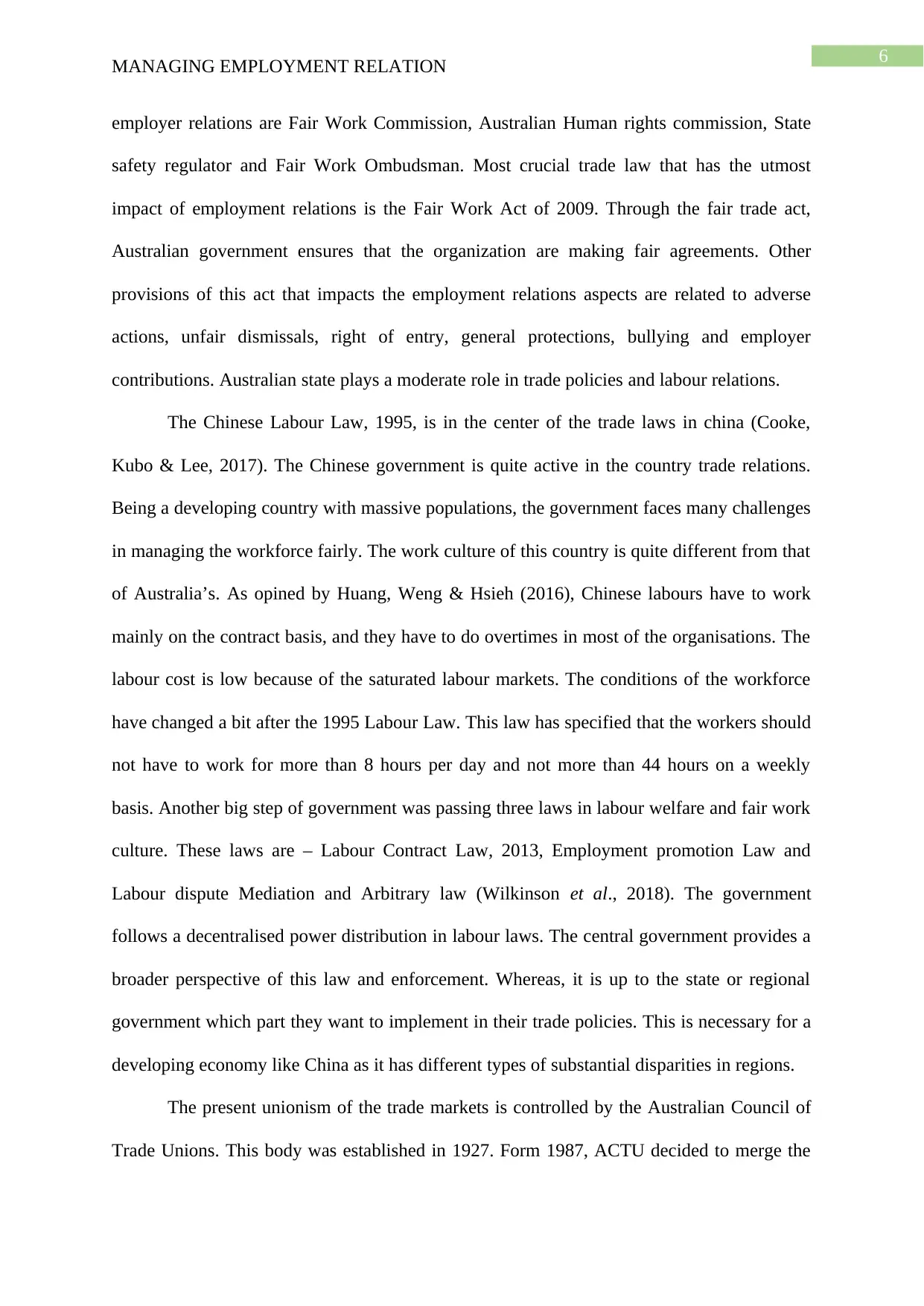
6
MANAGING EMPLOYMENT RELATION
employer relations are Fair Work Commission, Australian Human rights commission, State
safety regulator and Fair Work Ombudsman. Most crucial trade law that has the utmost
impact of employment relations is the Fair Work Act of 2009. Through the fair trade act,
Australian government ensures that the organization are making fair agreements. Other
provisions of this act that impacts the employment relations aspects are related to adverse
actions, unfair dismissals, right of entry, general protections, bullying and employer
contributions. Australian state plays a moderate role in trade policies and labour relations.
The Chinese Labour Law, 1995, is in the center of the trade laws in china (Cooke,
Kubo & Lee, 2017). The Chinese government is quite active in the country trade relations.
Being a developing country with massive populations, the government faces many challenges
in managing the workforce fairly. The work culture of this country is quite different from that
of Australia’s. As opined by Huang, Weng & Hsieh (2016), Chinese labours have to work
mainly on the contract basis, and they have to do overtimes in most of the organisations. The
labour cost is low because of the saturated labour markets. The conditions of the workforce
have changed a bit after the 1995 Labour Law. This law has specified that the workers should
not have to work for more than 8 hours per day and not more than 44 hours on a weekly
basis. Another big step of government was passing three laws in labour welfare and fair work
culture. These laws are – Labour Contract Law, 2013, Employment promotion Law and
Labour dispute Mediation and Arbitrary law (Wilkinson et al., 2018). The government
follows a decentralised power distribution in labour laws. The central government provides a
broader perspective of this law and enforcement. Whereas, it is up to the state or regional
government which part they want to implement in their trade policies. This is necessary for a
developing economy like China as it has different types of substantial disparities in regions.
The present unionism of the trade markets is controlled by the Australian Council of
Trade Unions. This body was established in 1927. Form 1987, ACTU decided to merge the
MANAGING EMPLOYMENT RELATION
employer relations are Fair Work Commission, Australian Human rights commission, State
safety regulator and Fair Work Ombudsman. Most crucial trade law that has the utmost
impact of employment relations is the Fair Work Act of 2009. Through the fair trade act,
Australian government ensures that the organization are making fair agreements. Other
provisions of this act that impacts the employment relations aspects are related to adverse
actions, unfair dismissals, right of entry, general protections, bullying and employer
contributions. Australian state plays a moderate role in trade policies and labour relations.
The Chinese Labour Law, 1995, is in the center of the trade laws in china (Cooke,
Kubo & Lee, 2017). The Chinese government is quite active in the country trade relations.
Being a developing country with massive populations, the government faces many challenges
in managing the workforce fairly. The work culture of this country is quite different from that
of Australia’s. As opined by Huang, Weng & Hsieh (2016), Chinese labours have to work
mainly on the contract basis, and they have to do overtimes in most of the organisations. The
labour cost is low because of the saturated labour markets. The conditions of the workforce
have changed a bit after the 1995 Labour Law. This law has specified that the workers should
not have to work for more than 8 hours per day and not more than 44 hours on a weekly
basis. Another big step of government was passing three laws in labour welfare and fair work
culture. These laws are – Labour Contract Law, 2013, Employment promotion Law and
Labour dispute Mediation and Arbitrary law (Wilkinson et al., 2018). The government
follows a decentralised power distribution in labour laws. The central government provides a
broader perspective of this law and enforcement. Whereas, it is up to the state or regional
government which part they want to implement in their trade policies. This is necessary for a
developing economy like China as it has different types of substantial disparities in regions.
The present unionism of the trade markets is controlled by the Australian Council of
Trade Unions. This body was established in 1927. Form 1987, ACTU decided to merge the
Paraphrase This Document
Need a fresh take? Get an instant paraphrase of this document with our AI Paraphraser
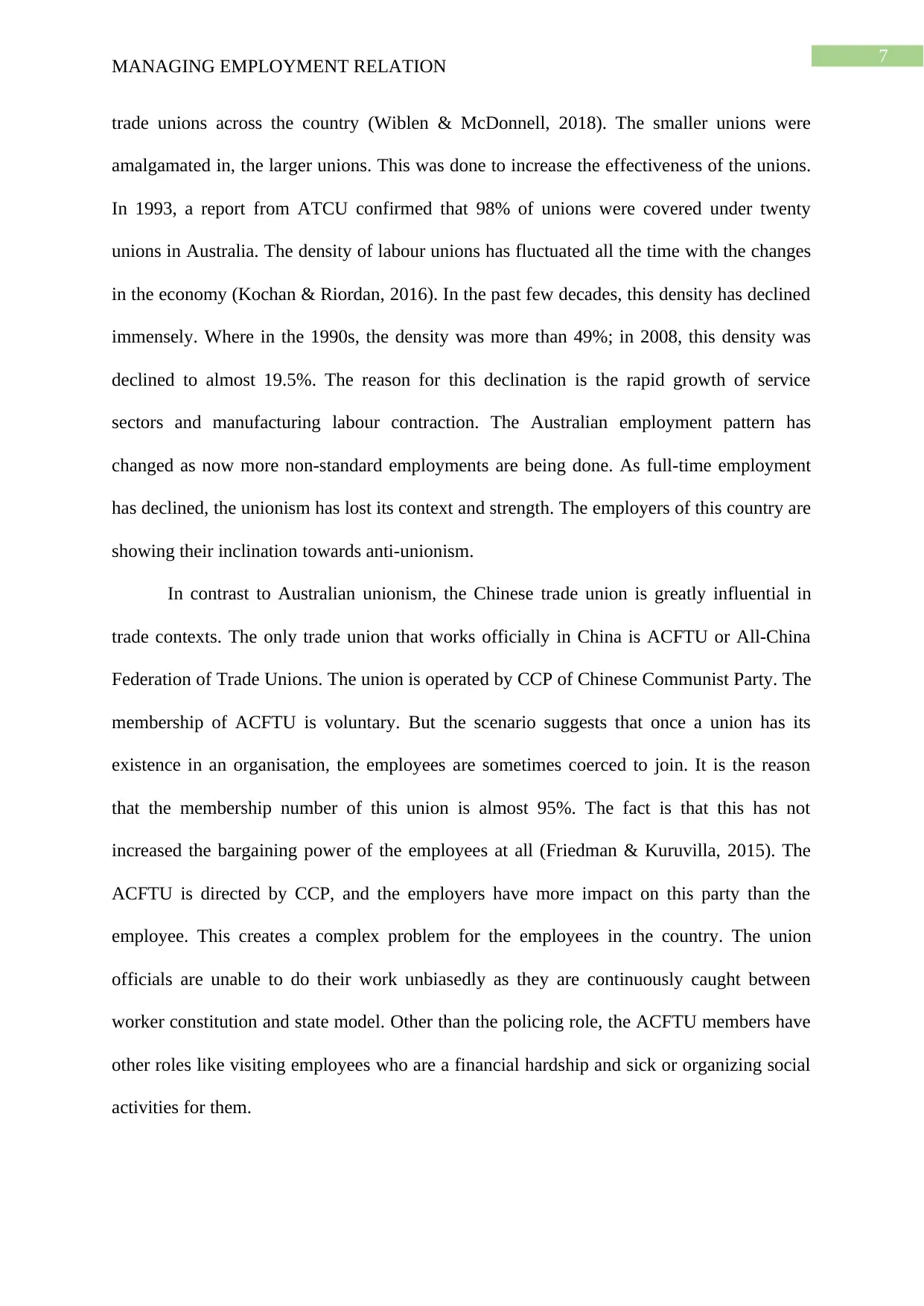
7
MANAGING EMPLOYMENT RELATION
trade unions across the country (Wiblen & McDonnell, 2018). The smaller unions were
amalgamated in, the larger unions. This was done to increase the effectiveness of the unions.
In 1993, a report from ATCU confirmed that 98% of unions were covered under twenty
unions in Australia. The density of labour unions has fluctuated all the time with the changes
in the economy (Kochan & Riordan, 2016). In the past few decades, this density has declined
immensely. Where in the 1990s, the density was more than 49%; in 2008, this density was
declined to almost 19.5%. The reason for this declination is the rapid growth of service
sectors and manufacturing labour contraction. The Australian employment pattern has
changed as now more non-standard employments are being done. As full-time employment
has declined, the unionism has lost its context and strength. The employers of this country are
showing their inclination towards anti-unionism.
In contrast to Australian unionism, the Chinese trade union is greatly influential in
trade contexts. The only trade union that works officially in China is ACFTU or All-China
Federation of Trade Unions. The union is operated by CCP of Chinese Communist Party. The
membership of ACFTU is voluntary. But the scenario suggests that once a union has its
existence in an organisation, the employees are sometimes coerced to join. It is the reason
that the membership number of this union is almost 95%. The fact is that this has not
increased the bargaining power of the employees at all (Friedman & Kuruvilla, 2015). The
ACFTU is directed by CCP, and the employers have more impact on this party than the
employee. This creates a complex problem for the employees in the country. The union
officials are unable to do their work unbiasedly as they are continuously caught between
worker constitution and state model. Other than the policing role, the ACFTU members have
other roles like visiting employees who are a financial hardship and sick or organizing social
activities for them.
MANAGING EMPLOYMENT RELATION
trade unions across the country (Wiblen & McDonnell, 2018). The smaller unions were
amalgamated in, the larger unions. This was done to increase the effectiveness of the unions.
In 1993, a report from ATCU confirmed that 98% of unions were covered under twenty
unions in Australia. The density of labour unions has fluctuated all the time with the changes
in the economy (Kochan & Riordan, 2016). In the past few decades, this density has declined
immensely. Where in the 1990s, the density was more than 49%; in 2008, this density was
declined to almost 19.5%. The reason for this declination is the rapid growth of service
sectors and manufacturing labour contraction. The Australian employment pattern has
changed as now more non-standard employments are being done. As full-time employment
has declined, the unionism has lost its context and strength. The employers of this country are
showing their inclination towards anti-unionism.
In contrast to Australian unionism, the Chinese trade union is greatly influential in
trade contexts. The only trade union that works officially in China is ACFTU or All-China
Federation of Trade Unions. The union is operated by CCP of Chinese Communist Party. The
membership of ACFTU is voluntary. But the scenario suggests that once a union has its
existence in an organisation, the employees are sometimes coerced to join. It is the reason
that the membership number of this union is almost 95%. The fact is that this has not
increased the bargaining power of the employees at all (Friedman & Kuruvilla, 2015). The
ACFTU is directed by CCP, and the employers have more impact on this party than the
employee. This creates a complex problem for the employees in the country. The union
officials are unable to do their work unbiasedly as they are continuously caught between
worker constitution and state model. Other than the policing role, the ACFTU members have
other roles like visiting employees who are a financial hardship and sick or organizing social
activities for them.
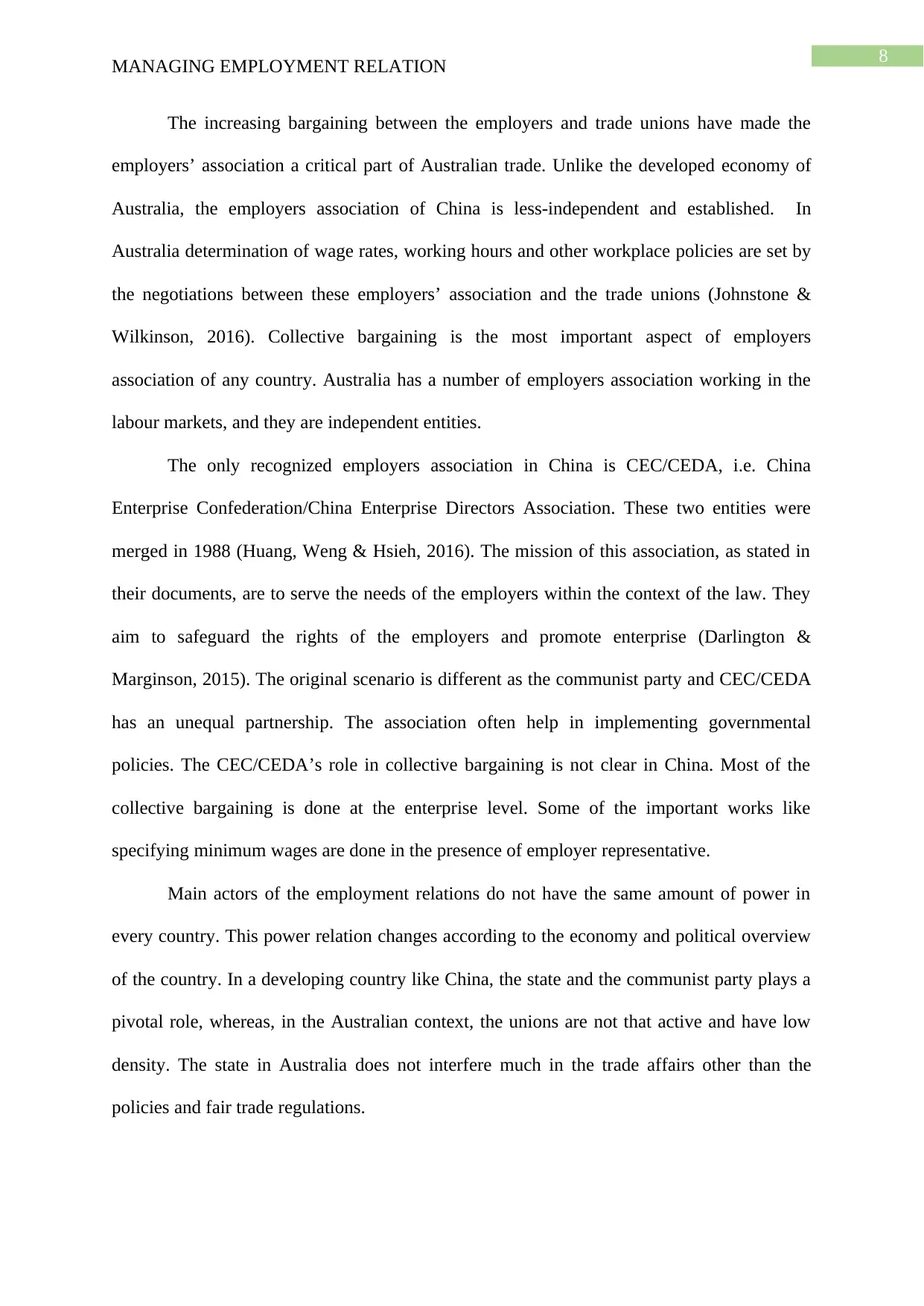
8
MANAGING EMPLOYMENT RELATION
The increasing bargaining between the employers and trade unions have made the
employers’ association a critical part of Australian trade. Unlike the developed economy of
Australia, the employers association of China is less-independent and established. In
Australia determination of wage rates, working hours and other workplace policies are set by
the negotiations between these employers’ association and the trade unions (Johnstone &
Wilkinson, 2016). Collective bargaining is the most important aspect of employers
association of any country. Australia has a number of employers association working in the
labour markets, and they are independent entities.
The only recognized employers association in China is CEC/CEDA, i.e. China
Enterprise Confederation/China Enterprise Directors Association. These two entities were
merged in 1988 (Huang, Weng & Hsieh, 2016). The mission of this association, as stated in
their documents, are to serve the needs of the employers within the context of the law. They
aim to safeguard the rights of the employers and promote enterprise (Darlington &
Marginson, 2015). The original scenario is different as the communist party and CEC/CEDA
has an unequal partnership. The association often help in implementing governmental
policies. The CEC/CEDA’s role in collective bargaining is not clear in China. Most of the
collective bargaining is done at the enterprise level. Some of the important works like
specifying minimum wages are done in the presence of employer representative.
Main actors of the employment relations do not have the same amount of power in
every country. This power relation changes according to the economy and political overview
of the country. In a developing country like China, the state and the communist party plays a
pivotal role, whereas, in the Australian context, the unions are not that active and have low
density. The state in Australia does not interfere much in the trade affairs other than the
policies and fair trade regulations.
MANAGING EMPLOYMENT RELATION
The increasing bargaining between the employers and trade unions have made the
employers’ association a critical part of Australian trade. Unlike the developed economy of
Australia, the employers association of China is less-independent and established. In
Australia determination of wage rates, working hours and other workplace policies are set by
the negotiations between these employers’ association and the trade unions (Johnstone &
Wilkinson, 2016). Collective bargaining is the most important aspect of employers
association of any country. Australia has a number of employers association working in the
labour markets, and they are independent entities.
The only recognized employers association in China is CEC/CEDA, i.e. China
Enterprise Confederation/China Enterprise Directors Association. These two entities were
merged in 1988 (Huang, Weng & Hsieh, 2016). The mission of this association, as stated in
their documents, are to serve the needs of the employers within the context of the law. They
aim to safeguard the rights of the employers and promote enterprise (Darlington &
Marginson, 2015). The original scenario is different as the communist party and CEC/CEDA
has an unequal partnership. The association often help in implementing governmental
policies. The CEC/CEDA’s role in collective bargaining is not clear in China. Most of the
collective bargaining is done at the enterprise level. Some of the important works like
specifying minimum wages are done in the presence of employer representative.
Main actors of the employment relations do not have the same amount of power in
every country. This power relation changes according to the economy and political overview
of the country. In a developing country like China, the state and the communist party plays a
pivotal role, whereas, in the Australian context, the unions are not that active and have low
density. The state in Australia does not interfere much in the trade affairs other than the
policies and fair trade regulations.
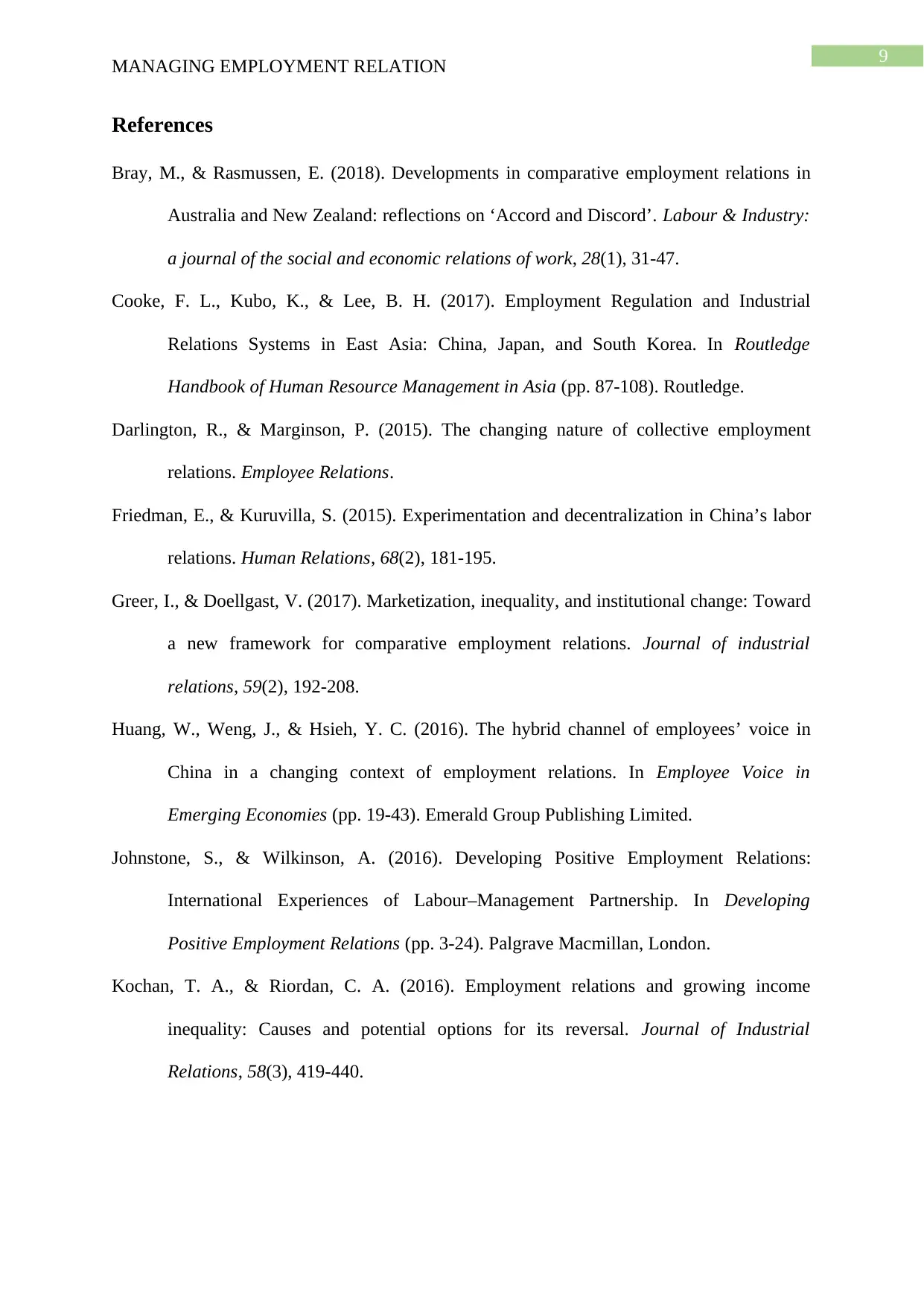
9
MANAGING EMPLOYMENT RELATION
References
Bray, M., & Rasmussen, E. (2018). Developments in comparative employment relations in
Australia and New Zealand: reflections on ‘Accord and Discord’. Labour & Industry:
a journal of the social and economic relations of work, 28(1), 31-47.
Cooke, F. L., Kubo, K., & Lee, B. H. (2017). Employment Regulation and Industrial
Relations Systems in East Asia: China, Japan, and South Korea. In Routledge
Handbook of Human Resource Management in Asia (pp. 87-108). Routledge.
Darlington, R., & Marginson, P. (2015). The changing nature of collective employment
relations. Employee Relations.
Friedman, E., & Kuruvilla, S. (2015). Experimentation and decentralization in China’s labor
relations. Human Relations, 68(2), 181-195.
Greer, I., & Doellgast, V. (2017). Marketization, inequality, and institutional change: Toward
a new framework for comparative employment relations. Journal of industrial
relations, 59(2), 192-208.
Huang, W., Weng, J., & Hsieh, Y. C. (2016). The hybrid channel of employees’ voice in
China in a changing context of employment relations. In Employee Voice in
Emerging Economies (pp. 19-43). Emerald Group Publishing Limited.
Johnstone, S., & Wilkinson, A. (2016). Developing Positive Employment Relations:
International Experiences of Labour–Management Partnership. In Developing
Positive Employment Relations (pp. 3-24). Palgrave Macmillan, London.
Kochan, T. A., & Riordan, C. A. (2016). Employment relations and growing income
inequality: Causes and potential options for its reversal. Journal of Industrial
Relations, 58(3), 419-440.
MANAGING EMPLOYMENT RELATION
References
Bray, M., & Rasmussen, E. (2018). Developments in comparative employment relations in
Australia and New Zealand: reflections on ‘Accord and Discord’. Labour & Industry:
a journal of the social and economic relations of work, 28(1), 31-47.
Cooke, F. L., Kubo, K., & Lee, B. H. (2017). Employment Regulation and Industrial
Relations Systems in East Asia: China, Japan, and South Korea. In Routledge
Handbook of Human Resource Management in Asia (pp. 87-108). Routledge.
Darlington, R., & Marginson, P. (2015). The changing nature of collective employment
relations. Employee Relations.
Friedman, E., & Kuruvilla, S. (2015). Experimentation and decentralization in China’s labor
relations. Human Relations, 68(2), 181-195.
Greer, I., & Doellgast, V. (2017). Marketization, inequality, and institutional change: Toward
a new framework for comparative employment relations. Journal of industrial
relations, 59(2), 192-208.
Huang, W., Weng, J., & Hsieh, Y. C. (2016). The hybrid channel of employees’ voice in
China in a changing context of employment relations. In Employee Voice in
Emerging Economies (pp. 19-43). Emerald Group Publishing Limited.
Johnstone, S., & Wilkinson, A. (2016). Developing Positive Employment Relations:
International Experiences of Labour–Management Partnership. In Developing
Positive Employment Relations (pp. 3-24). Palgrave Macmillan, London.
Kochan, T. A., & Riordan, C. A. (2016). Employment relations and growing income
inequality: Causes and potential options for its reversal. Journal of Industrial
Relations, 58(3), 419-440.
Secure Best Marks with AI Grader
Need help grading? Try our AI Grader for instant feedback on your assignments.
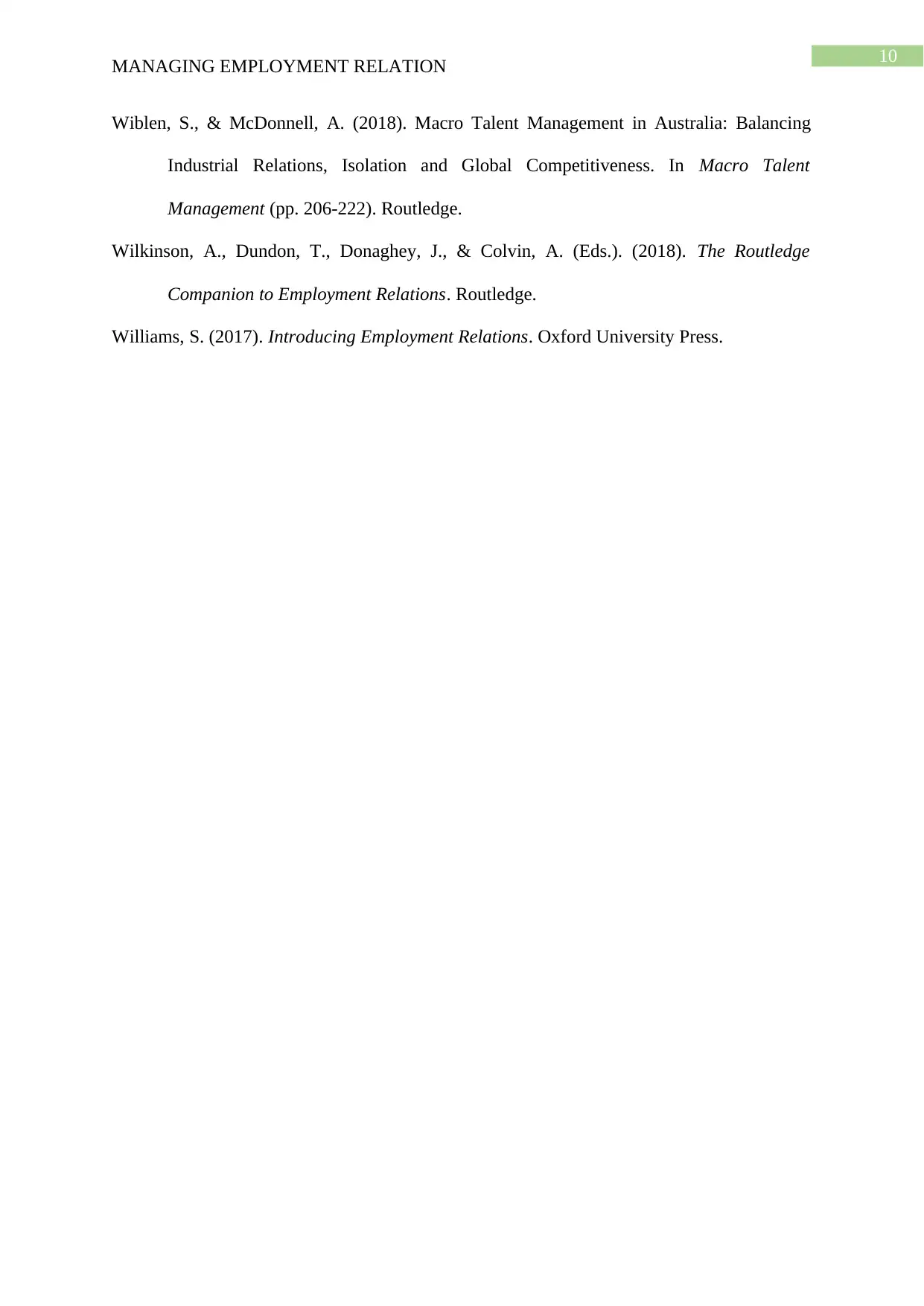
10
MANAGING EMPLOYMENT RELATION
Wiblen, S., & McDonnell, A. (2018). Macro Talent Management in Australia: Balancing
Industrial Relations, Isolation and Global Competitiveness. In Macro Talent
Management (pp. 206-222). Routledge.
Wilkinson, A., Dundon, T., Donaghey, J., & Colvin, A. (Eds.). (2018). The Routledge
Companion to Employment Relations. Routledge.
Williams, S. (2017). Introducing Employment Relations. Oxford University Press.
MANAGING EMPLOYMENT RELATION
Wiblen, S., & McDonnell, A. (2018). Macro Talent Management in Australia: Balancing
Industrial Relations, Isolation and Global Competitiveness. In Macro Talent
Management (pp. 206-222). Routledge.
Wilkinson, A., Dundon, T., Donaghey, J., & Colvin, A. (Eds.). (2018). The Routledge
Companion to Employment Relations. Routledge.
Williams, S. (2017). Introducing Employment Relations. Oxford University Press.
1 out of 11
Related Documents
Your All-in-One AI-Powered Toolkit for Academic Success.
+13062052269
info@desklib.com
Available 24*7 on WhatsApp / Email
![[object Object]](/_next/static/media/star-bottom.7253800d.svg)
Unlock your academic potential
© 2024 | Zucol Services PVT LTD | All rights reserved.





